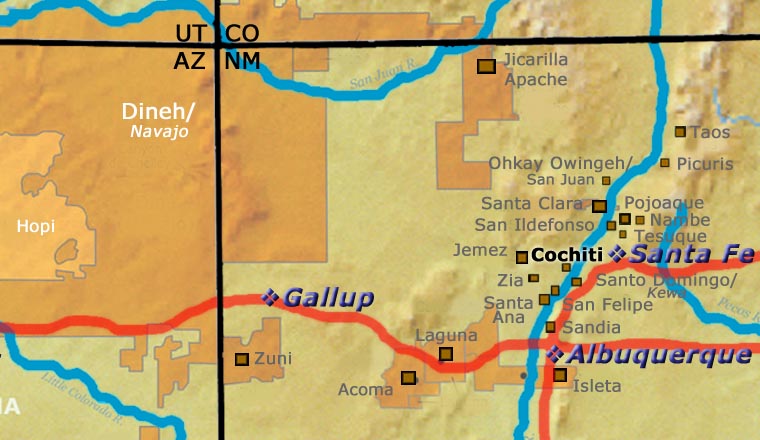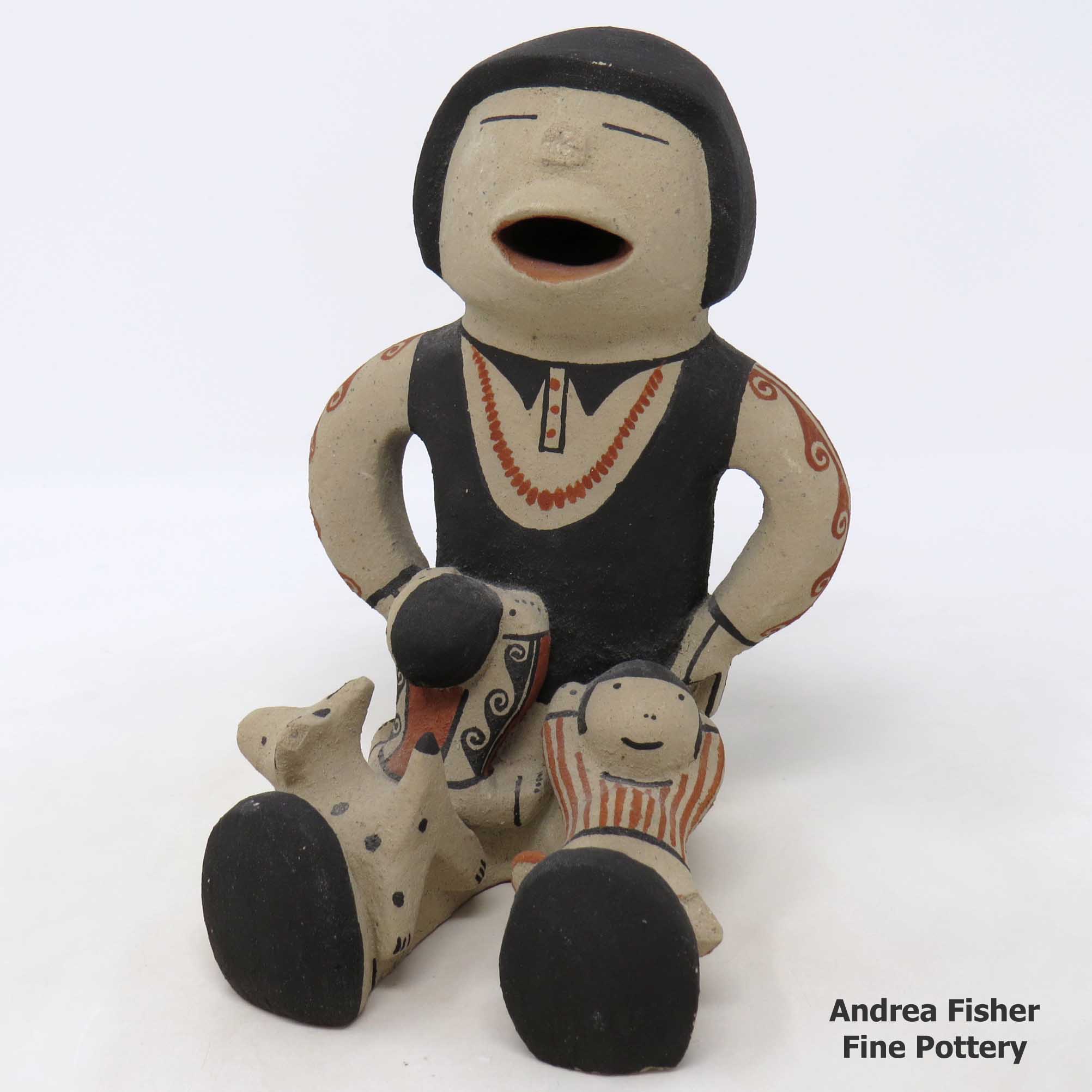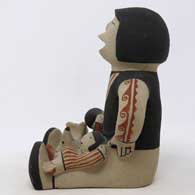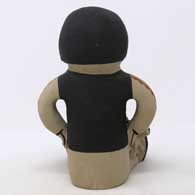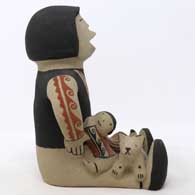
Buffy Cordero
Cochiti
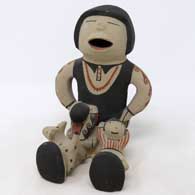
Elizabeth "Buffy" Cordero-Suina was born to George Cordero and Kathy Cordero at Cochiti Pueblo in November, 1969. She learned to make pottery through watching and working with her father and her famous grandmother, Helen Cordero.
When Buffy was a child, her family lived in a home behind her grandmother's. That made it easy to visit. She remembers sitting at her grandmother's workbench day after day and asking her "What are you making today?" Then when she was about 11, Helen didn't answer, she just tossed Buffy a lump of clay. That's when Buffy made her first little animal figure.
Buffy says she is like her grandmother: not very good at making bowls or pots of any sort. But making figures is different. Even the clay mix is different. Helen preferred using a gray base clay instead of the more abundant red clay found around Cochiti. Buffy learned to add volcanic ash with a little sand to that gray clay to make her pieces. Then she applies a white slip over the finished surface and polishes that before adding painted decorations.
A strict traditionalist, Buffy always follows her grandmother's instructions faithfully. All of her materials are strictly natural, including the mineral paints she used (in her words: "I don't want to use weird color paint"). She doesn't work on Sundays or on feast days. She never fires when it's windy or wet. She also never fires a piece when anyone other than members of her immediate family are watching (Helen never allowed anyone to watch either).
Buffy's favorite style to make is the family's trademark storyteller, with lots of children on them. Her father's storytellers were almost indistinguishable from his mother, Helen's, but Buffy's are quite distinct. Nearly all of Buffy's storytellers have a dog on them, because Buffy's children like dogs. But even more of a trademark for her is the little boy either reclining on his back or standing with his hands on his hips.
Like her grandmother, Buffy has also made a few "Children's Story Hour" sets with a larger grandfather figure singing to separate smaller children figures scattered on the floor around him.
Early in her career, Buffy decided she wouldn't do anything new unless it came directly from the pueblo life around her: a scene, a dance, a ceremony. She was not going to make figures of tourists, circus performers, bearded ladies or mermaids like many Cochiti potters were making before she was born.
Some Exhibits that featured Buffy's work
- Pottery by American Indian Women: The Legacy of Generations. Heard Museum. Phoenix, AZ. February 14, 1998 - May 17, 1998
- Pottery by American Indian Women: The Legacy of Generations. The Museum of Women in the Arts. Washington, DC. October 9, 1997 - January 11, 1998
- American Indian Art Festival and Market. Artist Square, Dallas Arts District, Dallas, TX. November 9, 1990 - November 11, 1990
100 West San Francisco Street, Santa Fe, New Mexico 87501
(505) 986-1234 - www.andreafisherpottery.com - All Rights Reserved

Cochiti Pueblo
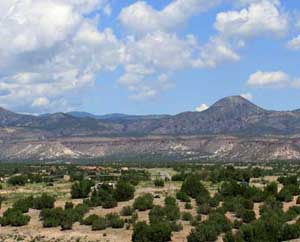
View west across Cochiti Pueblo
Cochiti Pueblo lies fifteen miles south of Santa Fe along the west bank of the Rio Grande. Frijoles Canyon in what is now Bandelier National Monument is the site of the pueblo's most recent ancestral home. The Eastern Keresans may have relocated to the Bandelier area from the Four Corners region around 1300.
Cochiti legend says that Clay Old Woman and Clay Old Man came to visit the Cochitis. While all the people watched, Clay Old Woman shaped a pot. Clay Old Man danced too close and kicked the pot. He rolled the clay from the broken pot into a ball, gave a piece to all the women in the village and told them never to forget to make pottery.
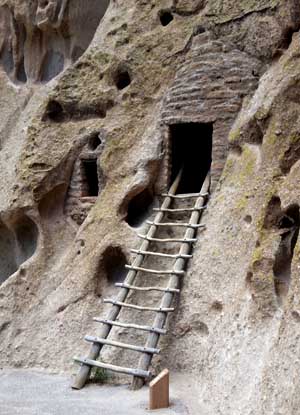
At Bandelier National Monument
In prehistoric times, human effigy pots, animals, duck canteens and bird shaped pitchers with beaks as spouts were common productions of the Cochiti potters. Many of these were condemned as idols and destroyed by the Franciscan priests. That problem stopped when the Spanish left in 1820 but the fantastic array of figurines created by Cochiti potters was essentially dormant until the railroad arrived. Then Cochiti potters were among the first to enter the tourist market and they produced many whimsical figures into the early 1900s. Then production followed the market into more conventional shapes.
Legend has it that a Ringling Brothers Circus train broke down near Cochiti Pueblo in the 1920s. Supposedly, the tribe's contact with the ringmaster, trapeze artists, opera singers, sideshow quot;freaks" and exotic animals paved the way for a variety of new figural subjects. However, shortly after the railroad passed through, a delegation of Cochiti men got on the train and traveled to Washington DC. There they were introduced to the President, spoke to Congress, and were taken on a tour of the "highlights" of American civilization in Washington and in New York City, incuding the Metropolitan Opera, the Bronx Zoo and a performance of the Ringling Brothers Circus. As none of the men could read or write, nor draw, what they brought back to Cochiti was what they remembered of things they had never seen before. The stories they told must have been wild. An astute observer will find angels, nativities, cowboys, tourist caricatures, snakes, dinosaurs, turtles, goats, two-headed opera singers, clowns, tattooed strongmen, Moorish nuns and even mermaids in the Cochiti pottery pantheon, many produced only since the early 1960s and based on characters described in Cochiti's oral history.
A few modern potters make traditional styled pots with black and red flowers, animals, clouds, lightning and geometric designs but most Cochiti pottery artists now create figurines. Most notable is the storyteller, a grandfather or grandmother figure with "babies" perched on it. Helen Cordero is credited with creating the first storyteller in 1964 to honor her grandfather. The storyteller style was quickly picked up by other pueblos and each modified the form to match their local situation (ie: clay colors and tribal and religious traditions). In some pueblos, storytellers are also now made as drummers and as a large variety of animals.
Today, Cochiti potters face the challenge of acquiring the clay for the white slip. Construction of Cochiti Dam in the 1960s destroyed their primary source of their trademark white slip and gray clay. Now the white slip comes from one dwindling source at Santo Domingo, Cochiti Pueblo's neighbor to the south.
Most outsiders who visit Cochiti Pueblo these days do so on the way to or from either the recreation area on Cochiti Lake or Kasha-Katuwe Tent Rocks National Monument.
100 West San Francisco Street, Santa Fe, New Mexico 87501
(505) 986-1234 - www.andreafisherpottery.com - All Rights Reserved

Cochiti
$ 1450
bmcog9191
Grandfather storyteller with 2 children and a puppy
6.25 in H by 4.75 in Dia
Condition: Very good with a broken nose and broken foot on one child, priced accordingly
Signature: Buffy Cordero Suina
100 West San Francisco Street, Santa Fe, New Mexico 87501
(505) 986-1234 - www.andreafisherpottery.com - All Rights Reserved

Storytellers
Pueblos: Cochiti, Jemez, Acoma, Isleta, Santa Clara
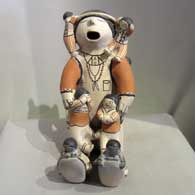
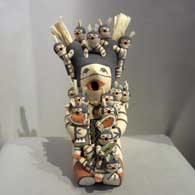

Historically, clay figures have been present in the Pueblo pottery tradition for most of the last thousand years. However, figures and effigies were denounced as "works of the devil" by the Spanish missionaries in New Mexico between 1540 and 1820. Before and after that time the art of making figurative sculpture flourished, especially at Cochiti Pueblo. The forms of animals, birds and caricatures of outsiders and, more recently, of images of mothers and grandfathers telling stories and singing to children have multiplied.
The "storyteller" is an important role in the tribe as parents are often too busy working and raising kids to pass on their tribal histories and the Native American people did not have a written language to record anything for posterity. The closest thing they had to a written language was pottery and the designs that decorated that pottery. So the storyteller's role was to preserve and retell and pass down the oral history of his people. In most tribes that role was fulfilled by men.
The first real storyteller figure was created in 1964 by Cochiti Pueblo potter Helen Cordero in memory of her grandfather, Santiago Quintana. She gathered her clay from a secret sacred place on the lands of her pueblo. Then she hand-coiled, hand painted and fired that first storyteller figure the traditional way: in the ground. Helen never used any molds or kilns to make her pottery.
Helen's creation struck a chord throughout all the pueblos as the storyteller is a figure central to all their societies. Most tribes also have the figure of the Singing Maiden in their pantheon and in many cases, the mix of Singing Maiden and Storyteller has blurred some lines in the pottery world. Today, as many as three hundred potters in thirteen pueblos have created storytellers, and their storytellers are not only men and women, but also Santa's, mudheads, koshares, bears, owls and other animals, sometimes encumbered with children numbering more than one hundred! Each potter has also customized their storyteller figures to more closely reflect the styles and dress of their own tribes, sometimes even of their own clans.
100 West San Francisco Street, Santa Fe, New Mexico 87501
(505) 986-1234 - www.andreafisherpottery.com - All Rights Reserved

Santiago Cordero Family Tree
Disclaimer: This "family tree" is a best effort on our part to determine who the potters are in this family and arrange them in a generational order. The general information available is questionable so we have tried to show each of these diagrams to living members of each family to get their input and approval, too. This diagram is subject to change should we get better info.
- Santiago Cordero (1876-) & Lorenza Cordero (c. 1874-)
- Juanita Cordero Arquero (c. 1906-)
Her students:
- Felecita Eustace (1927-2016) & Ben Eustace (Zuni)(c. 1920s-)
- Joseph (Lambert) Eustace (1960-)
- Helen Cordero (see below)
- Felecita Eustace (1927-2016) & Ben Eustace (Zuni)(c. 1920s-)
- Helen Cordero (1915-1994) & Fred Cordero
- George Cordero (1944-1990) & Kathy Cordero
- Buffy Cordero (1969-)
- Toni Suina (c. 1948-) & Del Trancosa (1951-)
- Leonard Trujillo (1936-2017) & Mary Trujillo (1937-2021)
- Geraldine Trujillo
- April Trujillo
- Geraldine Trujillo
- George Cordero (1944-1990) & Kathy Cordero
- Ramona Cordero
- Santiago Cordero (1876-) & Damacia Cordero (1905-1989)
- Josephine Arquero (1928-)
- Martha Arquero (1944-)
- Gloria Herrera
- Marie Laweka (1931-2002)
- Josephine Laweka (1960-2008)
Damacia's students: - Dorothy Trujillo (Jemez/Laguna, married into Cochiti) (niece, 1932-1999)
- Judith A. Suina (1960-)
- Cecilia V. Trujillo (1954-)
- Onofre Trujillo Jr. (c. 1969-) Dorothy's students:
- Norma A. Suina (1944-)
Some of the above info is drawn from Southern Pueblo Pottery, 2000 Artist Biographies, by Gregory Schaaf, © 2002, Center for Indigenous Arts & Studies
Other info is derived from personal contacts with family members and through interminable searches of the Internet and cross-examination of the data found.
(505) 986-1234 - www.andreafisherpottery.com - All Rights Reserved
